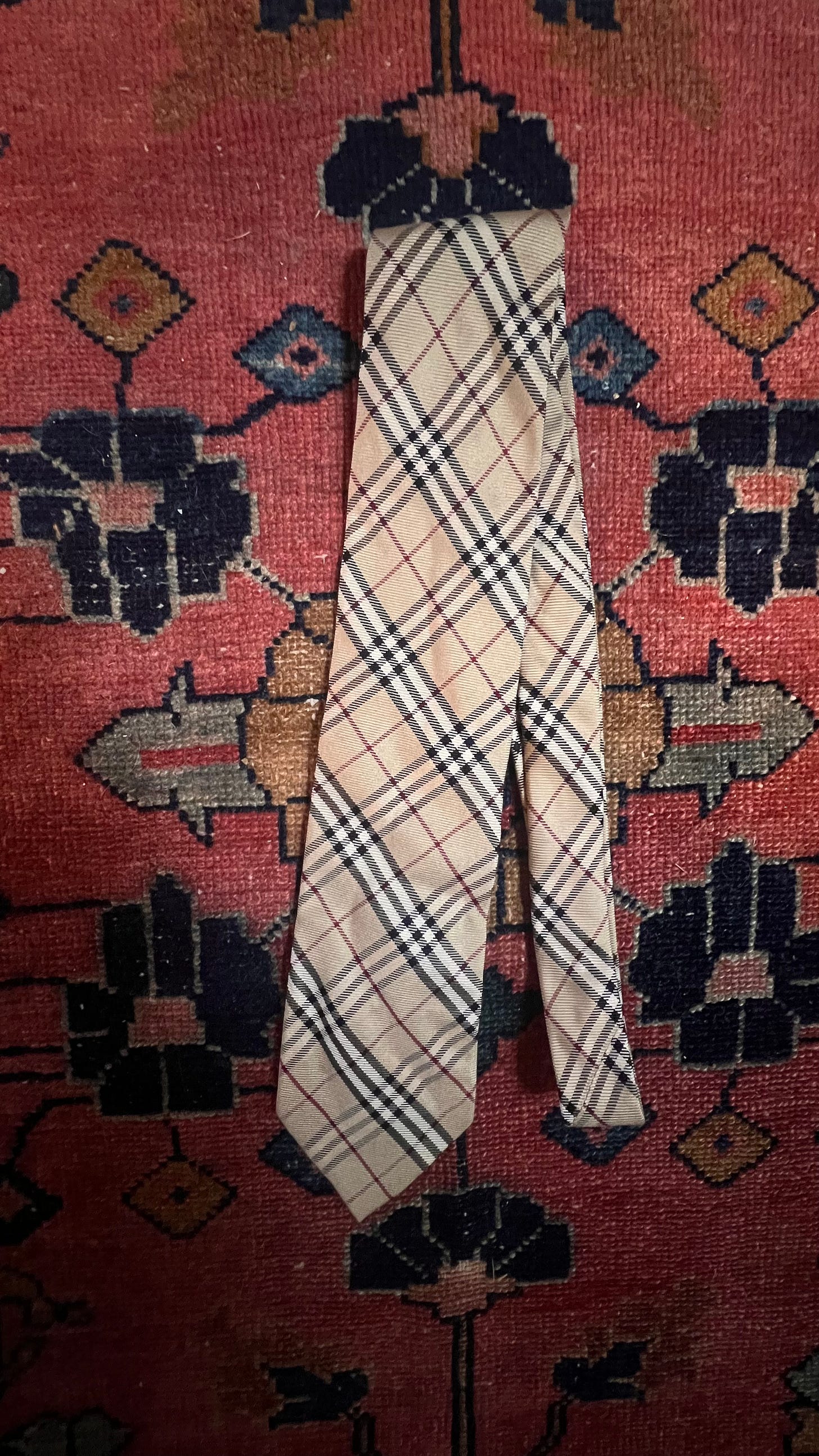Burberry Tie.
I pulled out the tie from the bag like a knight unsheathing Excalibur. The silk shimmered in the dim apartment light, its texture smooth and luxurious in my hands.
The night before I left on my mission, I lay awake in my bedroom, staring at the ceiling. My future felt like an ominous void, a journey I couldn’t see but had overwhelming anxious anticipation for. For the young Mormon boy, this day is like a football player’s evening before the Superbowl. Everything had built up to this. A swirl of emotions churned inside me—excitement, fear, pride, and doubt—all colliding in a way I couldn’t sort out. Either way, sleep was out of reach.
A knock broke the quiet.
It was my dad. He stepped into the dark room calmly, like he always did, and I noticed he was holding something in his hands. Something I’d never seen before. He approached my bed and held it out, almost reverently, like an offering laid on an altar.
It was a tie. A green plaid tie made of wool, worn but sturdy. Very Scottish looking.
“This was my favorite tie on my mission,” he said. “Now it’s yours.”
I sat up, running my fingers across the fabric. The tie was older than I was, and the plaid pattern looked like something straight out of the 1970s. But to me, it felt like he was handing me a piece of himself, a part of his own journey that I would carry with me into mine. I nodded and managed a quiet, “Thanks, Dad.”
As he left the room, I held the tie to my chest then tossed it in my suitcase.
Shortly after, I fell asleep.
For Mormon missionaries, ties are more than accessories—they’re lifelines of self-expression. Every morning, you find yourself putting on the same white shirt, the same black slacks, the same black name badge. But the tie? The tie is where you can show a hint of individuality. Stripes, polka dots, paisleys—each one is a small personal expression against the unrelenting sea of monotony.
When I left home to begin my two-year mission, I packed exactly 12 ties. A modest collection to some, standard for most. By the time I returned home, I had 96. Every missionary grows their collection over time, trading ties with companions, finding hidden gems at thrift stores, or, in rare cases, splurging on something truly special.
This is the story of my most coveted tie—the Burberry checkered tie—and the lengths I went to make it mine.
After a year on my mission, the novelty of ties had worn off. By then, they all seemed dull. Pink tie? Overplayed. Paisley tie? Too much. Solid color? Snooze. There was only one kind of tie left that could reignite my excitement: a designer tie. Something luxurious. Something bold. Something that, to my knowledge, no Mormon missionary I’d ever met had worn.
And then I saw it.
It was winter, Christmastime 2007, and we were at the library sending our weekly emails home. While waiting for my companion to finish, I wandered over to the magazine rack. My eyes gazed toward that secular section filled with Sports Illustrated and Good Housekeeping. I thought to myself, “Looking at the covers shouldn’t hurt.” That’s when I spotted it—a glossy issue of GQ, practically glowing under the fluorescent lights. I glanced around to make sure no one else was watching, grabbed it and flipped it open.
And there it was, like a piece of art draped across a marble pedestal, the Burberry checkered tie.
Tan silk, with the iconic red and black checks. A masterpiece. I swear I could hear the Mormon Tabernacle Choir singing as my eyes remained glued to the page. It was perfect. Sophisticated. Confident. And most importantly, individualistic. This tie wasn’t just calling my name—it was shouting it: Elder Shinnick, drape me around your neck.
That Christmas, I’d received a $150 Visa gift card from my family back home. It was meant for practical things—a new suit, maybe, or a stockpile of white shirts. But all I could think about was that tie. I needed it like a dying man needs water. It wasn’t just a tie. It was now my identity.
As the days passed, I couldn’t get the thought of the tie out of my head. With the card burning in my pocket, I convinced my companion to swing by the Cheyenne Wyoming Mall. We headed straight for Macy’s, where I combed through racks of ties with the urgency of someone digging for buried treasure. But the Burberry tie wasn’t there.
A sales associate approached, his raised eyebrows giving away what he thought of two Mormon missionaries in suits scouring the designer section. Still, I asked: “Do you have any Burberry ties?”
He looked at me skeptically, like he couldn’t imagine why a missionary would want a designer tie. “Not here,” he said. “The closest store that might carry one is in Denver. Cherry Creek Shopping Center.”
My heart sank. Denver was outside our mission boundaries—off-limits. There was no way I’d ever get there and no way I’d ever get this tie. It was 2007. Online shopping was not what it is today nor, if it was, would I be allowed as a 20-year-old Mormon missionary to go to the proper website to order it.
I left the store defeated as the Visa gift card still lay in my front pocket.
For days, I stared at that gift card sitting on the windowsill next to my bed. Practical ideas surfaced—maybe I should buy a dozen ties at TJ Maxx, or a suit from Target—but I knew they couldn’t touch the joy I’d felt just thinking about the Burberry tie. This now, wasn’t about practicality. It was about purpose. It was about expression. It was about Individuality. And it was just out of reach.
One evening we had dinner with a young couple in the congregation who had just bought a brand-new house in an upscale neighborhood. Everything in their home was pristine and modern, from the sleek kitchen to the spotless white carpet. As we talked over dessert underneath the freshly hung chandelier, the wife briefly mentioned, “I’m heading down to Denver this weekend to do some Christmas shopping at Cherry Creek.”
Cherry Creek? My ears perked. My heart jumped. This was my chance.
I hesitated for a moment. Would she think I was crazy? A missionary asking her to buy a Burberry tie? It felt ridiculous. But I had no other options. Like a contestant on Shark Tank, I pitched my case. I told her about the tie, the gift card, everything.
To my amazement, she agreed.
The next week was agony. I didn’t know when she was going or if she’d even find the tie. What if she forgot? What if she thought better of it and decided not to help?
Every night, I dreamed about that tie—the sleek Italian silk, the unmistakable Burberry checks. This anticipation for this tie had grown to be more than just a piece of clothing. To me, it was a signal to the world that I wasn’t just another missionary in a sea of white shirts. I had taste. I had style. I was a human.
One particularly cold, windy evening, we came home early. As we pulled into our crumbling apartment complex, I saw a bag hanging on the door handle, flapping in the heavy winter winds of Cheyenne. My heart leaped. I rushed inside, tore the bag open, and there it was.
The tie.
I pulled it out like a knight unsheathing Excalibur as my desktop lamp illuminated the shimmering silk within in the dim apartment light. As I ran my fingers across it, the smooth texture was supple in my hands. As I examined the Burberry tag on the back, I could see that every stitch was a testament to craftsmanship. As I draped it around my neck and tied a double Windsor knot, it slid into place with an ease I’d never experienced before from a necktie. I knew this tie could be different and now I knew it was.
I stared at myself in the mirror, grinning. This tie was freedom.
Later that night, as I hung up my clothes, I reached for the worn wire hanger reserved for my special ties. I then carefully draped my Burberry tie over it before placing, right beside it, my father’s green plaid tie.
THE BURBERRY TIE. I KEPT IT.






